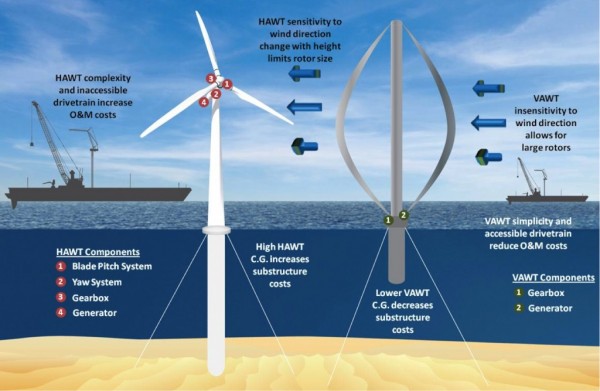Advancing technology, siting offshore turbines and wind farms, and reducing offshore wind’s cost of energy
Leveraging our rotor systems optimization capabilities in wind plants, we couple controls, loads and dynamics to optimal floating topologies, lowering the cost of energy of future coastal power plants. Sandia leads innovation inoffshore wind technology through:
- Development of optimal topology for very large floating wind turbines in deep waters
- Control integrated stability and force control with performance
- High-fidelity platform design and optimization
- Floating platform material optimization
- Deep water mooring solutions
- Extreme conditions and condition monitoring
- Development of mid-fidelity offshore wind plant flow simulator
- Resource assessment and characterization
Research Areas
Sandia applies decades of land-based wind experience to address the research challenges posed by offshore wind turbine siting and technology development. As part of the U.S. Department of Energy’s offshore wind program, we conduct research with two primary goals in mind: to reduce the technology risks associated with offshore wind power generation and to reduce the levelized cost of energy.
- Floating Vertical Axis Wind Turbine
- Large Offshore Rotor Development
- Modeling Codes for Simulating Offshore Wind Farms
- Structural Health & Prognostics Management
- Sediment Transport & Scour Analysis
Resources
Offshore Wind Energy Validation Experiment Roadmap
The reliance of offshore wind energy applications on computational modeling is expected to
grow considerably with high impact on risk-based investment decisions. The Offshore Wind
Energy Validation Experiment Roadmap coordinates the validation needs of the suite of
computational physics-based models that will be developed and applied in the offshore wind
program, identifying validation experiments that target the unique needs for offshore wind
energy. This effort has been organized into five phenomena areas: mesoscale air (atmospheric
physics), microscale air (wind turbine and wind plant aerodynamics), water (hydrodynamics),
structures and soil. These phenomena areas must all address four fundamental needs to assess
model adequacy for the intended application: verification and validation, uncertainty
quantification, validation experiments and instrumentation development.
Innovative Vertical Axis Wind Turbine
Estimates suggest that more than 2000 GW of wind energy are available offshore in water more than
60 meters deep. To access this tremendous energy resource, Sandia is developing and evaluating floating wind turbines.
In deep-water environments, vertical-axis wind turbines (VAWTs) have inherent advantages over horizontal-axis wind turbines (HAWTs), including lower capital, operational, and maintenance costs. Sandia combines more than 35 years of applied research on VAWT technology and advanced analysis tools to design systems suitable for deep-water environments.
Resources
ExaWind
What is the ExaWind software?
- An open-source collection of codes for wind turbine and wind farm simulations
- Downloadable here: https://github.com/Exawind
- Multi-fidelity: actuator disk (low fidelity) to highest-fidelity full-blade-resolved simulations
- Backed by rigorous verification and validation
- Established with modern software engineering, with a focus on performance portability
- Funded by multiple projects
- Code development team spans multiple organizations (primarily NREL, Sandia, ORNL, and LBNL)
What are the goals of the ExaWind team?
- Provide pathways to understanding wind plant physics and reducing wind plant losses
- Enable generation of simulation data and knowledge foundations for the next-generation of design tools
- Provide software tools for exploring disruptive wind energy generation technology innovations quickly and with confidence
Contact
Brandon Ennis, Offshore Design Optimization
blennis@sandia.gov
Paul Crozier, ExaWind
pscrozi@sandia.gov
